What happened to cause the Baltimore Key Bridge to collapse? Around 01:28 on Tuesday, March 27th, the Singapore-flagged vessel named DALI collided with Baltimore’s iconic Francis Scott Key Bridge, causing its collapse into the Patapsco River.
Pole Star Global has taken a moment of silence to reflect on the gravity of this situation. The team extends their deepest sympathies to all those affected and expresses gratitude for the swift response of search and rescue teams and authorities.
Pole Star Global remains vigilant in monitoring the situation closely, refraining from disclosing information until enough data has been collected to furnish accurate and timely insights. Using these insights, this article will assess the current situation following Baltimore’s bridge collapse, including:
- An analysis of import and export trade through the Port of Baltimore.
- An assessment of vessel traffic in the area (commercial and non-commercial)
This article is structured as follows:
- Understanding the Incident: A Timeline of Events
- Assessing the Immediate Impact of Baltimore’s Bridge Collapse on Maritime Trade
- About DALI: Pole Star Global’s Ship and Flag Watchlist Checks
Understanding the Incident: A Timeline of Events
At the time of the incident, the vessel DALI was transporting 4,699 twenty-foot equivalent units of cargo from East Asia to the US East Coast via the Panama Canal. The ship arrived at the Seagirt Marine Terminal in Baltimore on March 24th, following a delivery to the Port of New York/New Jersey. Before its return journey to Asia early Tuesday morning (see Figure 1), a small portion of containers had been offloaded.
Figure 1: DALI’s Route Before Colliding with Baltimore’s Francis Scott Key Bridge
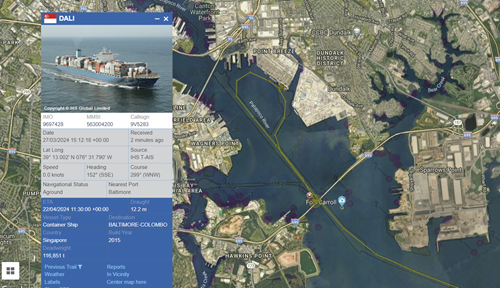
Image shows DALI began its return journey to Asia, after visiting the Seagirt Marine Terminal in Baltimore on the 24th of March. Image obtained from Pole Star Global’s Maritime Domain Awareness (MDA) platform.
Departing from Baltimore’s Seagirt Marine Terminal at approximately 00:24 local time on Tuesday, the DALI was bound for Colombo, Sri Lanka.
- At 01:24, as the ship approached the bridge, the vessel experienced a loss of power causing the lights to go out onboard.
- At 01:25, the lights came back on as smoke emanated from the ship’s funnel.
- At 01:26, the DALI changed course but appeared to lose power again.
- The critical moment occurred at 01:28 when the ship collided with a pillar of Baltimore’s bridge, causing the central and southern spans to collapse upon impact.
- Shortly after, at 01:28, the northern span of the bridge also collapsed, causing complete destruction.
What Caused This Collision?
It has been speculated that the incident was caused by either an engine failure, steering failure, or generator blackout. However, at present, it’s hard to establish causality.
Looking at DALI’s history, it’s noteworthy that this isn’t the first time the ship has been involved in an accident. Back in 2016, while trying to depart from the Belgian port of Antwerp, the ship grazed its stern against the quay, causing significant damage to the hull. Luckily, there were no injuries or spills reported during that incident.
Yet these past issues cannot be used to assign blame today. Instead, these instances should be put into perspective by looking at the broader picture. If you consider DALI’s overall track record using Pole Star Global’s PurpleTRAC, only two recorded deficiencies have been reported in approximately 8 years, alongside 27 Port State Control (PSC) inspections. This performance is generally commendable and also worth noting.
Assessing the Immediate Impact of the Baltimore Key Bridge Collapse on Maritime Trade
Baltimore’s Francis Scott Key Bridge links Hawkins Point – a neighbourhood in Baltimore – to Dundalk – in Maryland – while allowing commercial vessels to traverse the Patapsco River, which links the Port of Baltimore with Chesapeake Bay – the largest estuary in the United States. As such, the port of Baltimore stands out as one of the busiest in the United States in terms of cargo volume and value. In fact, according to the IMF’s Port Watch, “Baltimore handles nearly 3% of US maritime trade, serving as a major port for the import and export of motorised vehicles.”
Consequently, the collapse of Baltimore’s bridge carries significant implications for global supply chains. To evaluate this impact, Pole Star Global continues to monitor vessel movement within the area.
Analysing the Impact of the Baltimore Key Bridge Collapse on Import and Export Trade
Figure 2 shows the number of commercial vessels calling at Baltimore, categorised by ship type and identified through Pole Star Global’s MDA platform. (Please note that tugboats, non-merchant vessels, and other non-commercial vessel types are not included in this dataset.)
Figure 2: The Number of Vessels Calling at the Port of Baltimore (Categorised by Ship Type Between January 2023 – March 2024)
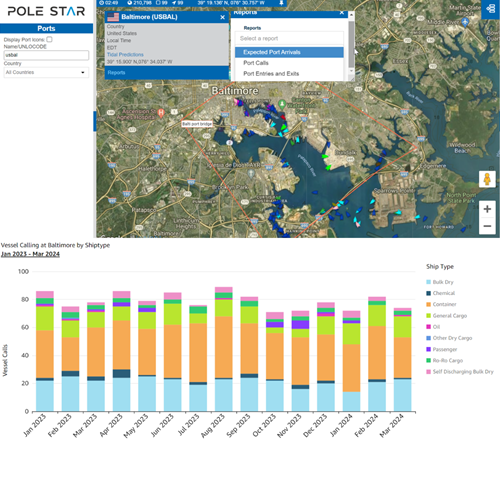
Note that there’s a greater number of container and bulk dry vessels calling at the Port of Baltimore. This aligns with the port’s commodity export and import data (see Figures 3 and 4 respectively, data obtained from the Bureau of Transportation Statistics). Manufactured goods, predominantly motorised vehicles, were the top commodities exported and imported via the Port of Baltimore in 2022.
Figure 3: Top 5 Commodities Exported via the Port of Baltimore in 2022 (By Value)
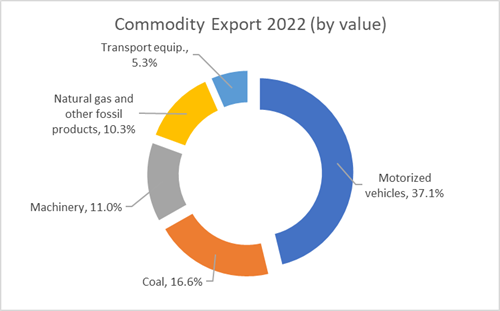
Figure 4: Top 5 Commodities Imported via the Port of Baltimore in 2022 (By Value)
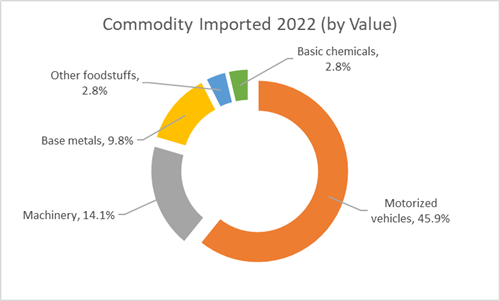
Figures 3 and 4 provide insight into the industries that will bear the brunt of Baltimore’s Francis Scott Key Bridge collapse. Notably, these are automotive, oil and gas, and heavy industries.
In addition, as depicted in Figure 5, the majority of imports and exports from the Port of Baltimore involve routes to and from Europe. Plus, observing the width of the bands, it’s apparent that exports are less compared to imports in this area (data obtained from the Bureau of Transportation Statistics).
Figure 5: Export (Left) and Import (Right) Value for the Port of Baltimore in 2022
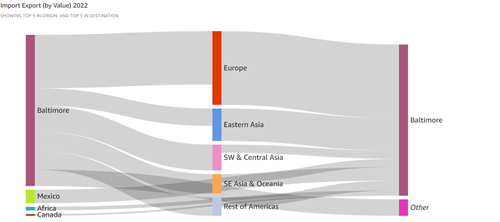
Analysing the Impact of the Baltimore Key Bridge Collapse on Import and Export Trade Through the Port of Baltimore: Concluding Remarks
Using the above insights, Pole Star Global has drawn the following conclusions. That is, the collapse of Baltimore’s Francis Scott Key Bridge will:
- Primarily affect supply chains reliant on imports into the Baltimore port.
- Mainly impact supply chains involved in trade between Baltimore and Europe.
- Predominantly affect container, coal, and bulk dry shipping.
Assessing the Impact of the Baltimore Key Bridge Collapse on Vessel Traffic in the Area (Commercial and Non-commercial)
At the time of the incident, Pole Star Global recorded 32 vessels within the port area. The total number of vessels (commercial and non-commercial) calling at the Port of Baltimore varies from 25-30 per day (see Figure 6).
Figure 6: The Number of Vessels Calling at the Port of Baltimore (Daily) Up Until the 25th of March 2024
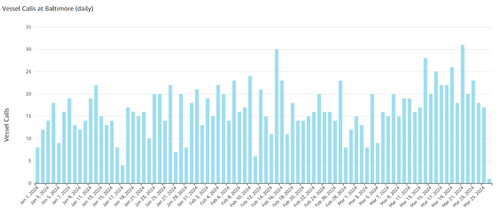
Yet, the impact of the bridge collapse extends well beyond Baltimore’s immediate vicinity. This means other ports and redirected shipping routes must be considered. For instance, according to container shipping expert Lars Jansen, the incident is a “major disaster” with widespread consequences for U.S. importers and exporters, and as a result, shipping lines are redirecting vessels to alternate ports along the East Coast.
More specifically, Pole Star Global’s AIS data reveals that at least 50% of the vessels initially bound for Baltimore have been rerouted to ports such as Philadelphia, Savannah, Jacksonville, and Wilmington. Some vessels have even adjusted their course, travelling at speeds below 2 knots near the southern coast of Virginia, while one vessel has redirected its journey to a port in Peru.
In terms of numbers, 30 vessels have either altered their course or are currently in transit, with 15 having diverted to ports on the East Coast (e.g. Wilmington and Savannah). Eight vessels are still en route and indicate the Port of Baltimore as their destination. Two of these vessels have already reached Sparrows Point, the outermost area of the port. (It’s important to note that Sparrow Point remains unaffected by the incident and continues to accommodate incoming vessels.)
How Has the Baltimore Key Bridge Collapse Impacted Major Shipping Lines?
- Attention has been drawn to major shipping lines, namely Cosco, Evergreen, and CMA CGM, as they’ve invoked force majeure. This means that the onus is now on cargo owners to retrieve their goods from alternate ports
- Hapag-Lloyd’s customer advisory stated that all containers originally bound for Baltimore will be rerouted to New York in a move to streamline operations amidst the disruption.
- Meanwhile, Maersk, the charterer of the DALI, shared insights in their advisory, highlighting plans to discharge cargo at alternative US East Coast Ports, terminating voyages there. Plus Maersk emphasised, “There will be an offer to customers on a case-by-case basis to cater for inland movements due to limited truck/rail capacity available“.
- MSC is also diverting its ships from Baltimore to New York and Newark.
Assessing the Impact of the Baltimore’s Bridge Collapse on Vessel Traffic in the Area (Commercial and Non-commercial): Concluding Remarks
- Considering that around 25-30 vessels typically dock at the Port of Baltimore daily, and given that at least 50% of these ships have been redirected, the scale of vessel rerouting needed in light of the incident becomes clear.
About DALI: Pole Star Global’s Ship and Flag Watchlist Checks
Pole Star Global reports that the DALI has been a Singapore-flagged vessel (see Figure 7) since October 2016. At the time of the incident, certificates attesting to the structural integrity and functionality of the vessel’s equipment were valid.
Figure 7: The DALI Is a Singapore-flagged Vessel With Valid Certification Ensuring the Structural Integrity of the Ship.
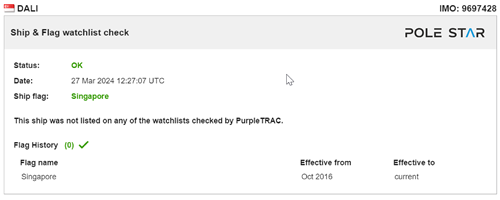
The DALI was flagged with Singapore at the time of the incident with valid certification ensuring the structural integrity of the ship.
Built by South Korea’s Hyundai Heavy Industries on behalf of Greek shipowner Oceanbulk, the DALI is currently under the management of the charter vessel company Synergy Group.
Additionally, and as previously mentioned, the DALI had been temporarily leased to the container shipping giant Maersk (see Figure 8). Maersk clarified that the DALI was carrying cargo for their customers but emphasised that no company personnel were aboard at the time of the collision.
Figure 8: A Summary of the DALI’s Credentials
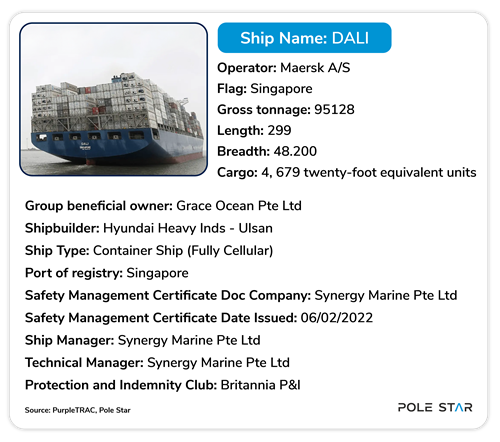
A Ship Movement History Check indicates that this is not the DALIi’s first visit to Baltimore, plus it has also made stops at other US ports, as depicted in Figure 9.
Figure 9: A Snapshot of the DALI’s Ship Movement History, Stopping at Multiple Ports in the US with a Previous Stop at the Port of Baltimore
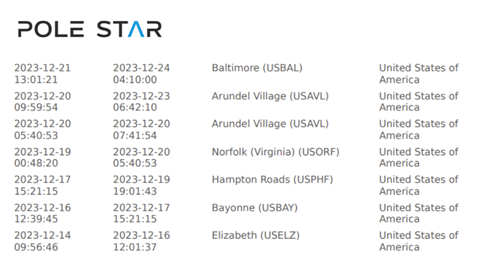
To summarise, a thorough examination of the above data presents no grounds for suspicion. The DALI boasts valid certification attesting to its structural soundness and maintains a reputable flag status. Notably, the ship’s manufacturers, owners, and operators are established entities within the maritime industry. Plus, the DALI is insured by the reputable Protection and Indemnity Club Britannia P&I. Ship movement history checks indicate the vessel was travelling via a recognised route and navigational patterns, which would only minimise the risk of collision.
Gain Actionable Visibility and Deeper Insights Into the Impact of Baltimore’s Bridge Collapse
Pole Star Global remains dedicated to closely monitoring the aftermath of the collision between the Singapore-flagged vessel DALI and Baltimore’s Francis Scott Key Bridge. Observing the immediate effects on vessel movement, import/export trade, and global supply chains will provide crucial insights.
For real-time tracking and to draw your conclusions, schedule a demo today to speak with a member of our team. Unlock actionable visibility and gain deeper insights into the impact of Baltimore’s bridge collapse with Pole Star Global.